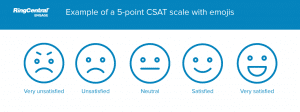Customer satisfaction is a core metric for companies. Satisfying customers has a number of benefits on the overall business, such as increasing loyalty and encouraging word-of-mouth.
Customer interactions take place on an increasing number of channels, on which customers are more and more demanding. Measuring customer satisfaction provides valuable insights to keep up with these expectations and adjust your strategy. In this article, we explain why customer satisfaction is important, how to measure it and how to improve it, with the help of 4 international experts!
Article summary:
I) What is Customer Satisfaction?
II) Customer satisfaction measurement
III) Limits of Customer Satisfaction
IV) A few ways to improve Customer Satisfaction
I) What is Customer Satisfaction?
1. Definition
Customer Satisfaction is a term everybody knows and the ultimate goal of all customer service departments. At first, the concept can seem quite broad: in this article, we focus on customer satisfaction as the measurement of how customers are happy with a product or service.
Ian Golding shared with us his definition of Customer Satisfaction:
| “Customer Satisfaction is the term typically used as a measure of how products and services supplied by an organisation meet or exceed customer expectation. Customer Satisfaction is usually captured through the distribution of surveys, asking customers to describe how satisfied they are with various touchpoints in their experience with the organisation – scoring on a scale and providing verbatim comments.” | |

|
Ian Golding
Global Customer Experience Specialist and Certified Customer Experience Professional, Author of “Customer What?” |
A good way to get a benchmark of CSAT is to look at the American Customer Satisfaction Index. According to their latest results, the overall U.S. customer satisfaction score equals 76.9% out of 100 for Q2 2018.
Over the same period, the top 3 sectors with the highest scores are Manufacturing, Accommodation & Food Services and Health Care & Social Assistance.
2. Why measure Customer Satisfaction
Measuring Customer Satisfaction is a key area of Customer Care. To enhance their strategy and keep up to date with customer expectations, companies need to constantly measure satisfaction. Measuring CSAT is a way to keep in line with customers’ expectations.
Some of the key benefits of customer satisfaction include:
- Showing your customers that you value their opinion and care about them
- Identify unhappy customers to take actions
- Identify happy customers to capitalize on their positive experience
- Better understand which areas of your customer care strategy must be improved
Ian Golding explains why CSAT is important and how it compares to NPS (Net Promoter Score):
| “Although a number of organisations have replaced Customer Satisfaction surveys with Net Promoter Score (NPS) Surveys over the years, Customer Satisfaction can still be a very useful indication of customer perception – principally because it is capturing perception at a number of touchpoints across the customer journey. Unlike NPS surveys, Customer Satisfaction surveys are often more granular AND therefore, more actionable. However, there has always been debate as to whether Customer Satisfaction is an indicator of loyalty and retention.” | |

|
Ian Golding
Global Customer Experience Specialist and Certified Customer Experience Professional, Author of “Customer What?” |
3. Why Customer Satisfaction is an important KPI for companies
Satisfied customers have a significant impact on the global activity . However, only 48% of consumers think that businesses are prioritizing their satisfaction and success. The same study shows that 83% of growing businesses rate customer satisfaction as “very important”. This outlines that customer experience is now a top priority and a factor of success.
Customer satisfaction positively impacts a number of other metrics:
- Contributing to brand loyalty: a satisfied customer will make business with the company again and develop loyalty. According to Harvard Business Review, acquiring a new customer can be 5 to 25 times more expensive than retaining an existing one. Then, the interest
- Increasing the customer’s lifetime value: a study from Infoquest found that a totally satisfied customer contributes 2.6 times as much revenue as a somewhat satisfied customer, and 14 times as much revenue as a somewhat dissatisfied customer.
- Encouraging word of mouth: if your customers are satisfied, they will most likely recommend you to their peers. According to Thinkjar, 72% of consumers will share a positive experience with 6 or more people.
- Increasing agent satisfaction: while there’s a strong focus on customer satisfaction, agent satisfaction is very important too. With an average turnover rate of 30 to 45% in contact centers, employee retention is a major challenge. CSAT and ASAT are dependent on each other. When customers are satisfied, agents can evolve in a more stimulating and rewarding environment.
| “In my opinion, Customer Satisfaction is a vitally important KPI as one of a suite of customer metrics (alongside NPS and Customer Effort). CSat surveys are the most likely to give you an accurate indication of the key drivers of customer perception and as such, the priorities for improvement in your customer journey.” | |

|
Ian Golding
Global Customer Experience Specialist and Certified Customer Experience Professional, Author of “Customer What?” |
II) Customer satisfaction measurement
1. Methods to measure it
- Customer Satisfaction Score
The CSAT Score is one of the most used metrics by customer service departments. It is measured by asking a satisfaction survey question like:
“How would you rate your overall satisfaction with the goods/service you received?”
CSAT Score usually ranges between 1 to 3, 1 to 5 or 1 to 10. The scale can be presented in different ways: numbers, sentences, emojis…

The advantage of the CSAT Score is that it is easy to implement and to get results: the customer can answer in only one click to choose the score. However, it does not provide a complete feedback, which can be obtained through a customer satisfaction survey.
- Customer Satisfaction survey
A customer satisfaction survey allows to collect feedback from customers. By asking different types of questions about the services/products, it goes more in-depth than the CSAT Score alone.
To get exploitable results and maximize the response rate, the survey implementation should be carefully done.
2. How to implement a relevant customer satisfaction survey
After deciding to measure Customer Satisfaction as part of your strategy, the implementation of your survey requires a particular methodology.
The first step is to make sure you know why it is used and how it will fit in your strategy. Here are a few questions to consider:
- When is it sent?
- How many questions are included?
- What’s the range for scale questions?
- What kind of feedback do you want to obtain?
“The majority of companies survey their customers on a regular basis but many suffer from low response rates. To escape this trap, here’s some things you should concentrate on when it comes to your own surveys:
|
|

|
Adrian Swinscoe
Customer Experience Advisor, Best-Selling Author & Forbes contributor |
3. How to exploit the results
After implementing the survey and getting data, comes the most important part: How to use customer satisfaction survey results? What to do with this data to improve customer experience?
It’s first important to note that data can be used both at the individual and aggregate level. With the results, you will know the satisfaction level of each customer, but you’ll also get the global satisfaction level of your customers.
- Follow up with respondents: whether they are satisfied or not, you should follow up with customers who shared their opinion. You should at least thank them for taking the time to answer. If you identify a specific problem with a customer, you should also take action to solve it and transform its negative experience into an outstanding one.
- Share results internally: customer satisfaction results should be shared with all departments across the company. Every department contributes to that satisfaction, so it’s important to make them aware of the results.
- Identify areas of improvement: when analyzing customers’ feedback, you will surely find which areas should be improved: is it a feature of the product? the sales process? a bad experience when interacting with your agents?
| “One of the reasons customers grow tired of being asked for feedback is it’s routinely ignored! Put your voice of customer data to good use by comparing what your happy and unhappy customers are telling you. Feedback from happy customers can highlight which aspects of your service are most important. I’ve also found that 5-10 percent of positive customer surveys contain some constructive comments—these customers love your brand or product and they really want to help.
Analyze what your unhappy customers are telling you to identify pain points. There are almost always a few themes that will emerge from simply reading customer comments. When you do spot an issue, find a way to fix it.” |
|

|
Jeff Toister
Author of “The Service Culture Handbook“ |
III) Limits of CSAT
1. Disadvantages
Like any other KPI, Customer Satisfaction comes with a number of disadvantages:
- Cultural bias: depending on the region, respondents can have very different ways to answer. According to Psychological Science, American people are more likely to choose the highest rate, while countries like Japan will be more moderate, even if they are fully satisfied. These differences should be considered to choose the right range.
- Psychological bias: a common disadvantage of CSAT outlined is that it can be influenced by the short-term sentiment of the customer, and not reflect his real opinion.
- Respondents: all customers do not fill in Customer Satisfaction surveys. For example, only 1 out of 26 unhappy customers complain, the 25 others churn without sharing their feedback.
| “All the major experience metrics have research both proving and disproving their position as the “best” indicator of downstream customer experience results, most particularly, loyalty. The issue is not that one metric is better than another. You can use NPS, CES, or CSAT — the bigger issue is when organizations focus only on the metric instead of on a comprehensive program of experience improvement which includes the metric.” | |

|
Adam Toporek
Customer Service Expert |
2. Alternatives
- Net Promoter Score (NPS)
Net Promoter Score (NPS) is a metric enabling to measure how likely customers are to recommend a product/service to their relatives.
It is calculated from the following question:
Would you recommend this company to a friend/colleague/relative?
It results, from 0 to 10, enable to identify 3 categories of customers: Detractors, Passives andPromoters.
One of the main differences between CSAT and NPS is that NPS evaluates the long-term customer’s relationship with the brand, while CSAT is more short-term, focused on the last experience with the brand.
To learn more about NPS, you can read our complete article: How important is NPS in your Customer Care strategy?
- Customer Effort Score (CES)
Customer Effort Score (CES) is used to measure the efforts customers make to interact with your business’ services and products. It allows companies to identify if customers have difficulties to perform certain actions.
While it is linked to customer satisfaction, it does not directly measure it. CES is then a complementary metric to CSAT to identify areas of improvement that might not be found in customer satisfaction surveys.

IV) A few ways to improve Customer Satisfaction
It’s important to know that every aspect of your business impacts customer satisfaction, making it impossible to give a universal customer satisfaction improvement plan.
However, we’ll share some customer service best practices to provide a better experience and contribute to a better CSAT.
1. Use data collected proactively
As we mentioned previously, it is essential to do something with the data collected. Collecting feedback is only the first step, it should then be used to improve products and services. The feedback is collected by customer service departments, but it can touch any department in the company: sales, product, marketing…
Making sense of data at an aggregate level enables to identify problems and solve them, while individual data can be used to proactively contact customers and ask further feedback or solve their problem.
2. Contact both happy and unhappy customers
Customer satisfaction results allows identifying both happy and unhappy customers. While companies should contact unsatisfied customers, they should also reach out to happy customers. Companies should capitalize on this satisfaction and make sure it is long term.
There are many ways to approach happy customers: offering them access to a special product or service, send them a special offer, communicate them details of your referral program… You can also ask them for further feedback, to better understand what makes them satisfied.
3. Provide a seamless experience across channels
CSAT results are heavily influenced by the customer experience when contacting companies. If customers can easily interact on multiple channels, at any time of the day, they will more likely be more satisfied that if they can only contact you by phone at certain hours.
With this multiplication of contact points, what becomes critical is the ability to provide a seamless experience across channels. When contacting you, customers just want to get their problem solved and don’t want to be dependent on the company’s processes.

Providing a mobile experience, fast answers and avoiding redirections will surely provide customers with a better experience, resulting in more satisfaction.
4. Work on other KPIs impacting satisfaction
Among the KPIs already tracked by the company, it is possible to find some impacting customers satisfaction.
First Contact Resolution Rate (FCR) is a critical KPI for customer service and is proven to have an impact on other call center metrics. According to SQM Group, a 1% improvement in FCR rate leads to a 1% improvement in satisfaction. When customers get their problem solved upon first contact and don’t have to contact the company multiple times, they are likely to give a better satisfaction score.
In the same way, average response time can have an impact on customer satisfaction. Customers now expect quick answers, especially on channels like live chat and messaging. If the company can respond as quickly as expected by customers, they are also more likely to be satisfied.
| “Obviously, the best methods for improving satisfaction are heavily dependent on the industry and the customer base. That said, two ways that you can improve satisfaction in almost any environment are reducing friction in the customer journey and improving the service interaction skills of your frontline teams.
Friction, effort, or as we like to view it, hassle, is an experience killer and often brings down CSAT scores. Likewise, when we look at what can really drive down satisfaction metrics, a poor experience interacting with a frontline rep can be incredibly damaging.” |
|

|
Adam Toporek
Customer Service Expert |
Conclusion
Customer satisfaction is a key KPI that should be measured by companies. This KPI helps to make sure you keep in line with your customers’ expectations. The feedback collected through surveys provides key insights, to better understand the what makes your customers happy or unhappy. With the multiplication of digital channels, measuring customer satisfaction becomes even more critical. By asking customers their feedback on each channel, you can more easily identify which touch points are the best and which ones should be improved. That way, you will be able to offer same quality of service across all channels, as expected by customers.
Updated Mar 13, 2025












